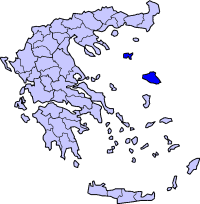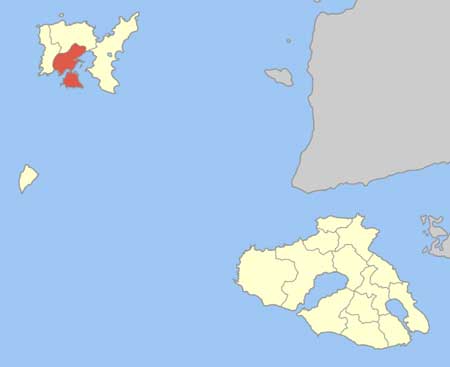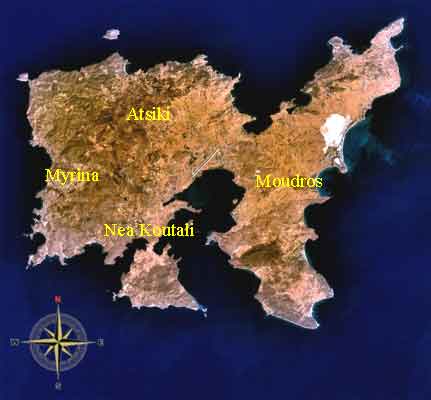.


Nea Koutali (Greek: Νέα Κούταλη) was until 2010 a municipality on the island of Lemnos, North Aegean, Greece.[1] Located in the south central portion of the island with a land area of 75.735 square kilometres (29.241 sq mi), it accounts for about 15.9% of the island's area, making it the smallest of the four municipalities on Lemnos. The seat of government is the town of Kontiás (population 628 as of the 2001 census), while its next largest town is Néa Koútali with 473 people. Nea Koutali's total population as of 2001 was 2,880.
Subdivisions
Nea Koutali is subdivided into the following communities with their constituent villages shown in brackets:
Angariones
Kallithea
Kontias
Livadochori (Livadochori, Poliochni)
Nea Koutali
Pedino (Neo Pedino, Palaio Pedino, Vounaria)
Portianou
Tsimandria
The municipality also includes the island of Vounaria and the uninhabited islands of Alogonisi, which form part of Pedino, as well as the islands of Kastria and Kompi (both part of Tsimandria).
Population
Year Village population Municipality population
1928 351 -
1951 457 -
1981 383 -
1991 438 2,901
2001 473 2,880
Geography
The area is almost entirely mountainous with several valleys consisting of predominantly farmland.
History
The village was built in the area of Agia Marina in 1926 by refugees from the former settlement of Koutali, which had existed since the (1919-22) Asia Minor Catastrophe. In its earliest years, it was part of Pesperago (now Pedino). In 1947, the area became part of the community of Nea Koutali, which later became a municipal district in 1998 when it received its municipal name and was absorped by it. Along with Agios Dimitrios, it became the second village built by refugees from Asia Minor.
Nea Koutali stands like an amphitheatre adjacent to the Moudros Gulf and stretches from the pine forests of Agia Triada to the stone built port filled with fishing boats.
Interwar period
In 1928, it had 351 inhabitants and later a school with only one pupil that was built in 1930 and which by 1938 had increased its student numbers to 70. This became a middle school in the 1950s then in 1973 amalgamated with Neo Pedino's school to become a five grade institution. Important improvement work at the school brought in students including Isidoros Damals (1932-44), Iordanis Alevropoulos (1944-46) and Stavroula Kratouni (1963-80).[clarification needed Why are these people notable?]
The village was built according to a uniform plan and had a population of 500 people in 1938. Its residents included sailors, fishermen and several farmers. In 1938, there were 15 sponge fishermen, 50 divers and 700 oka[clarification needed What is this?] fishermen producing trade worth 4 million drachmas. It had four oil machines[clarification needed What type of oil machines?] and three ships with passenger boats that provided everyday communication with the town of Moudros. There were 160 departures annually from the port.
Post-War period
After World War II and the Greek Civil War, Nea Koutali was one of the few village on the island to retain its population, which was 457 in 1951 and 473 in 2001. It built its own gymnasium (secondary school) in 1980-89 which serves the villages of central Lemnos together with a further school in Livadohori.
Economy
As much as it have the inevitable assimilation with the older Limniots, the Koutalianoi had participated into the same importantce and their diacritics which characterizes the island. It has their presences. Its residents with the gardens divides, brings in a different colour.
The village has its own kindergarten and public schools. It has fish taverns, unused bedrooms and runs its only rural plant. In recent years, several natural facilities and water by its bay along with its undepths salt marshes and a youth activity council around the soccer team Propontis in which it brought in distinction for several matches.
Nea Koutali is well known in Greece and abroad for its sponge production. Until today, rans a clean sponge factory which produces throughout the world. It runs a machine for salt and organized units of production. It receives better food in Lemnis in several taverns.
The Traditional Marine Museum
On July 1, 2006, the Traditional and Sponge Marine Museum opened. Its excellent galleries feature the maritime life of the Koutalians before they fled from [[Propontis]in 1922; displays include family jewels and the archived photos from the old Turkish hometown.
The museum is run by the Nea Koutali archeological council, it includes objects, even sponges from the depths of the sea and creates a large jar council, other ceramics, ancient anchors and other small objects from the ancient maritime life. It features amphorai (storage jars)found by fishermen which date back to Greek, Roman and the Byzantine times. They originated from different parts of the Aegean and the Mediterranean including Corinth, Chios, Thassos, Rhodes, Lesvos. They also originated from the Adriatic, Tarragon in northern Spain and Egypt.
There are also remarkable lead stocks from wooden anchors, as well as a number of inscriptions dating from the Byzantine period.
The running of the council occurred in the 1950s-1960s with the council made up of members of the Nea Koutali Public School.
Sources
•"Portianou of Lemnos" by Costas Kontellis, 1998. •"Lemnos and its villages" by Th. Belitsos 1994.
Vasiliki Tourptsoglou-Stefanidou Adventurous And Geographic Features On Lemnos Island (15th to 20th Centuries) (Ταξιδιωτικά και γεωγραφικά κείμενα για τη νήσο Λήμνο (15ος-20ος αιώνας) = Taxidiotika ke geografika kimena gia ti niso Limno (15os-20os eonas) Thessaloniki 1986
Lemnos/Limnos Province CD Rom (Cdrom Επαρχείου Λήμνου = CD Rom Eparcheiou Limnou): Lovable Lemnos
See also
List of places in the Lesbos prefecture
External links
Official website (Greek)
References
^ (In Greek) Kallikratis law Greece Ministry of Interior (Greek)
|
Municipalities and communities of the Lesbos Prefecture
Agia Paraskevi | Agiasos | Atsiki | Eresos-Antissa | Evergetoulas | Gera | Kalloni | Loutropoli Thermis | Mantamados | Mithymna | Moudros | Myrina | Mytilene | Nea Koutali | Petra | Plomari | Polichnitos |
| Ancient Greece
Science, Technology , Medicine , Warfare, , Biographies , Life , Cities/Places/Maps , Arts , Literature , Philosophy ,Olympics, Mythology , History , Images Medieval Greece / Byzantine Empire Science, Technology, Arts, , Warfare , Literature, Biographies, Icons, History Modern Greece Cities, Islands, Regions, Fauna/Flora ,Biographies , History , Warfare, Science/Technology, Literature, Music , Arts , Film/Actors , Sport , Fashion --- |
Retrieved from "http://en.wikipedia.org/"
All text is available under the terms of the GNU Free Documentation License



